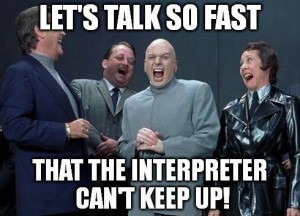The Merriam Webster Dictionary defines snide as: slyly disparaging.
Canon 1 of The Texas Court Interpreters Code of Ethics and Professional Responsibility states in part that” The interpreter shall render a complete and accurate interpretation without altering, omitting or adding to what is stated and without explanation. The register style and tone of the source language should be conserved “
This is why when a witness is snide, the professional interpreter repeats  the tone and the wording spoken despite the rudeness to the attorneys and the obstructions to a smooth deposition that attitude creates. It is really not fun for us either.
the tone and the wording spoken despite the rudeness to the attorneys and the obstructions to a smooth deposition that attitude creates. It is really not fun for us either.
It is also important for the interpreter to prepare to not be affected in any way by the rudeness that ensues. Instead you can prepare for delays, duration and a hostile environment. This way you can avoid any associated discomfort, fatigue or impediments to your performance.
Here are scenarios from when I interpreted for and observed several snide witnesses.
The witness: The tone is sarcastic. The pace of the responsiveness is either dragging, with long pauses or fast paced with sharp and snapping responses. For a fast paced testimony, it is best to interpret simultaneously.
The questioning attorney: may take a contentious tone or a passive one, In the latter situation they wait patiently for responses to questions. Either of these approaches extend the deposition. Finally they may request/insist that the lawyer representing the witness intervene. If the witness’s attorney does not intervene the deposition may be cut short.
The attorney for the witness can either intervene by instructing the witness to respond or take a break and do so privately. Otherwise, the attorney for the witness can ignore the situation entirely. In said situation the questioning attorney may respond more aggressively than is usual in depositions. The attorney for the witness may object as badgering. In my latest experience, there were no objections and the questions became faster, more compound and demanding. The witness became even more aggressive.
All persons who are on the record:
- Expect a lot of gestures such as eye rolling to exaggerated sighs, turning to co-counsel with expressions of shock/disbelief, head shaking and long deep stares with furrowed brows. Note: Interpreters do not convey or indicate gestures.
- There can be raised voices, talk overs and cursing.
- There can be reactionary behavior like pounding on the table, exhibits slapped on the table, exhibits tossed or pulled away.
When a witness replies refusing to state the requested information, the questioning attorney may remind them of the obligation they have to provide information in depositions. If the witness continues to refuse, the questioning lawyer may call the Judge to intervene and instruct the witness. The interpreter needs to stay until the deposition is officially ended on the record. Even then, the issue may not be resolved.
If you were contracted by an agency, you should notify them afterwards of the incident to keep them apprised. Do not comment in any way that can be considered your opinion on the situation. Do not show any displeasure or frustration to the attorneys.
Know that attorneys are trained for these situations. The best attorneys I know take it in stride. I suggest you perform like the best attorneys and continue to enjoy your work.


